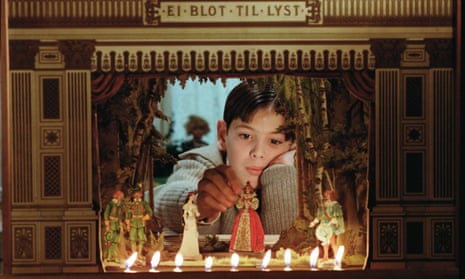The Swedish period drama Fanny and Alexander opens with a shot of a puppet theatre on which are inscribed the words Ei blot til lyst – “not solely for pleasure”. This motto sets the tone for the unconventional and often unnerving tale that follows: despite the 1982 film revolving substantially around Christmas festivities, it is no Hallmark holiday bauble. Rather, from that first meticulous frame to its last, director Ingmar Bergman seeks to convey a complex and often confronting story about grief, autonomy, and navigating the acts of one’s life.
Originally conceived as its director’s swan song, Fanny and Alexander tells of the large and loving Ekdahl family whose world is thrown off kilter when the father of the titular children dies, and their mother remarries. Much of the ensuing story is told through the eyes of Alexander (Bertil Guve), who struggles against his new stepfather – a pious and controlling bishop, played by Jan Malmsjö – and with his own terrors and visions. The real and the fantastic blur, the film combining the magic and the horror of classic fairytales as Alexander confronts his ghosts, while his mother Emilie (Ewa Fröling) attempts to free herself from a tyrannical husband.
The film is Dickensian in scope and in length. Clocking in at 312 minutes, the uncut version holds the curious honour of being one of the longest cinematic films in history. To its credit, however, no scene feels wasted, and the movie’s length enables it to follow characters closely, including through moments of stillness and contemplation that add emotional layers and expand the inner worlds of many among the film’s sprawling cast, to the point that they seem almost tangible.

The verisimilitude of these characters is part of what renders the film timeless and compelling. Forty years on, not only has Fanny and Alexander aged well in terms of narrative and production quality – its cinematography, by Sven Nykvist, is exquisite – but it also has contemporary relevance. Its clear-eyed exploration of trauma and grief, from the perspectives of children as well as adults, resonates strongly in the Covid era. It also perhaps uniquely nuanced in its portrayal of Christmas, effectively capturing the shifting tones and emotional palette of family festivities: joy intermingling with sadness, which moves rapidly to frustration and lies a mere knife’s edge away from love and its accompanying buzz of discontent and loneliness (this is a Bergman film, after all).
Bergman brings a great deal of empathy to his creations here, perhaps because this film is his most autobiographical – he himself was the son of a high-profile clergyman and grew up in a restrictive, punishing household. He avoids depicting any character as wholly good or evil, instead highlighting their contradictions. Bishop Vergérus, for example, whose portrayal by Malmsjö is widely considered one of Swedish cinema’s most frightening performances, is fanatical, intolerant and abusive – yet a few deliberate, understated shots of his interactions with his mother raise the sobering question of whether he learned such cruelty through suffering it. Moments like these ensure the personalities and human dilemmas populating the film remain vivid long after viewing.
The film feels modern in its relationships, too. Gustav Adolf (Jarl Kulle) and Alma Ekdahl (Mona Malm) have an open marriage that is consensual, loving, and accepted by their wider family, who embody a warm and inclusive “chosen family” ethos. The film also pre-empts contemporary discussions about coercive control, gaslighting and domestic abuse through the relationship of Bishop Vergérus and Emilie, showing how controlling tendencies can tumefy, and how abuse can flourish behind upstanding façades. It remains one of the most evocative depictions of abuse I have ever seen on screen; the film is valuable just for this alone.
after newsletter promotion
Fanny and Alexander is at its core a psychological drama through which Bergman explores various personal demons. Yet in Sweden it’s considered to be very much a Christmas film. The uncut version was regularly screened on Boxing Day, or Annandag Jul, throughout the 90s and early 2000s, creating a national tradition of sorts whereby many families would sit down with their Christmas leftovers and binge-watch this dark, five-hour classic. Perhaps its yuletide popularity may also be owed to the film’s tacit acknowledgement that life can feel melancholic and dislocated, or haunted by ghosts, even on the most joyful, festive of days. Fanny and Alexander is not a simple Christmas film – yet much like family and life, it is all the more beautiful for its complexities.
Fanny and Alexander (1982) can be streamed on Apple TV in Australia

Comments (…)
Sign in or create your Guardian account to join the discussion